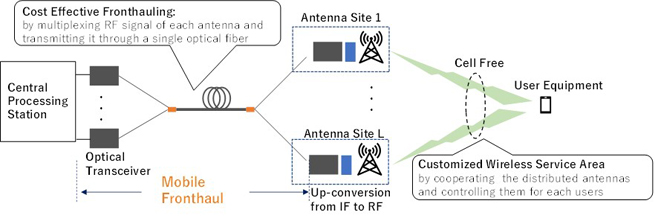 Print
Print
- Advanced Technology Laboratories
World first successful demonstration of wireless network deployment methodology for Beyond 5G
~New base station deployment with converged wireless and optical communication technologies~
October 7, 2021
KDDI Research, Inc.
KDDI Research, Inc. (Head Office: Fujimino, Saitama; President and CEO: Hajime Nakamura; hereinafter referred to as "KDDI Research") has conducted a successful demonstration of a next-generation wireless network deployment methodology. This will enable an appropriate wireless communication environment to be provided for each customer. This is the world's first successful demonstration of a combination of "Cell-Free massive MIMO, a base station cooperation technology that provides the preferable quality of wireless communication for individual customers using a massive number of distributed base station antennas, and "radio over fiber technology, an optical transmission technology of wireless signals that can efficiently accommodate a massive number of base stations with fewer optical fibers (Note 1). This demonstration showed that it is possible to achieve both low-cost and rapid deployment of base station antennas and to provide a wireless communication environment that satisfies the communication quality requirements of each customer.

Fig.1: Deployment of Cell-Free massive MIMO with optical fiber mobile fronthauling
【Background】
Since the launch of a 5G commercial service in March 2020, a wide variety of services that take advantage of the high speed and low latency features of 5G have appeared, and there have been rapid advances in R&D on the technologies for Beyond 5G, which will further enhance 5G network performance.
The communication system prior to the deployment of 5G was based on "cellular architecture" in which the communication service area is determined mainly by the location of the base station. Depending on customer position or time of use, this architecture may not always provide optimal communication quality due to the effects of interference caused by adjacent base stations. In addition, millimeter-wave signals, which are used in 5G networks to make enhanced mobile broadband communication services available, suffer from the shadowing effects created by buildings, and blockage by cars and people. This is due to their poor propagation characteristics toward users that are not in clear line-of-sight from a base station.
To resolve these problems, KDDI Research has been conducting research and development on Cell-Free Massive MIMO technology, which can reduce the effects of interference and blockage for individual customers by distributing and coordinating a massive number of base station antennas, and on infrastructure architecture that can efficiently accommodate the base station antennas with a smaller number of fibers.
【Research Results】
KDDI Research has successfully conducted the world's first demonstration experiment that verified the effectiveness of antenna cooperation among base stations by applying the IFoF scheme (Note 2), which is a radio over fiber technology, to the mobile fronthaul of Cell-Free massive MIMO. In this demonstration experiment, a millimeter-wave (28 GHz) wireless communication environment was established by connecting the 5G base station simulator (signaling tester) to multiple base station antennas with a single multicore optical fiber (Note 3), and transmitting the wireless signals from each base station antenna through the IFoF-based mobile fronthaul. By performing communication tests with commercial 5G terminals, we have confirmed that the following effects can be obtained by means of cooperation among the distributed antennas.
(1)Stable throughput can be obtained by mitigating the effects of blockage.
(2)Higher wireless communication quality can be maintained even when the distribution patterns of the antennas are changed.
In the IFoF scheme, wireless signals are transmitted as analog waveforms. This solves the problem of the increase in the optical transmission capacity of mobile fronthaul sections caused by digitizing high-speed wireless signals. At the same time, it is expected to significantly reduce the number and length of optical fibers required (Note 4) by accommodating the wireless signals for multiple antennas with various granularities and domains, such as core multiplexing, wavelength multiplexing, and IF frequency multiplexing, into a single optical fiber and transmitting the signals to the vicinity of the antennas. In addition, analog waveform transmission simplifies radio signal processing at the base stations, which contributes to reducing the energy consumption of a massive number of distributed antenna sites for Cell-Free massive MIMO.
【Vision for the future】
KDDI Research is working to realize a "user-centric network architecture" (Note 5) that enables customers to stably enjoy preferable communication services in a variety of environments.
In order to flexibly satisfy the communication quality requirements of a large number and variety of customers, the "user-centric network architecture" necessitates making the effects of Cell-Free Massive MIMO available to a large number of customers at the same time. In order to achieve this, high-speed network control and signal processing technologies and highly efficient and cost-effective network design will be of the utmost importance. We will continue to undertake and promote research and development that aims at the convergence of wireless and optical technologies. This will include investigating ways of combining fronthauling technology based on the IFoF scheme described in this press release with advanced technologies for Cell-Free massive MIMO.
【Related research achievements】
World’s First Demonstration of Radio over Fiber Technology for Mobile Networks with Large Capacity Transmission and Superior Installability (December 7, 2020)
【KDDI Research’s initiatives】
KDDI and KDDI Research formulated “KDDI Accelerate 5.0”, based on a concept for a next-generation society envisioned for 2030, and summarized how it can be accomplished in “Beyond 5G/6G White Paper” in terms of the “Future Image” and “Technologies” required to create an ecosystem that spurs innovation. To develop a new lifestyle, the two companies will continue to invest in R&D on seven different technologies and on an orchestration technology that links them together. The results presented in this study correspond to one of the seven technologies of the “Network.”
(Note1) First point is to demonstrate the feasibility of Cell-Free massive MIMO with an optical fiber mobile fronthauling scheme that efficiently accommodates multiple antennas of the base stations (according to KDDI Research’s survey October 7, 2021)
(Note2) IFoF=Intermediate Frequency over Fiber. Mobile Fronthauling scheme that multiplexes RF signals of different antennas converted to different intermediate frequencies and transmits them through a single optical fiber with one wavelength after analog optical modulation
(Note3) Optical fiber that has multiple cores for multiplexing different optical signals
(Note4) In the case where the distance between the central processing station and the antenna is 10 km, signals are transmitted by 8 antennas deployed at different locations, and the signals are multiplexed into one optical fiber, the estimated required optical fiber length can be reduced to about 1/5.
(Note5) A network architecture that KDDI has proposed towards b5G and 6G, in which multiple base station antennas cooperate to provide services that satisfy the increasingly diverse communication requirements of customers, and that is different from conventional cellular architecture where a specific base station is associated with an user.
※The information contained in the articles is current at the time of publication.Products, service fees, service content and specifications, contact information, and other details are subject to change without notice.